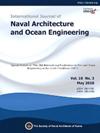提高舱室空间通行效率:一种集成智能算法和通行能力的潜艇布局优化方法
IF 3.9
3区 工程技术
Q2 ENGINEERING, MARINE
International Journal of Naval Architecture and Ocean Engineering
Pub Date : 2025-01-01
DOI:10.1016/j.ijnaoe.2025.100672
引用次数: 0
摘要
潜艇的密闭空间严重阻碍了艇员的操作和机动性。为了提高潜艇内部通道效率,本文提出了以通道容量为关键因素的通道效率驱动布局优化策略(PEDLOS)。使用当前模拟布局的通道模拟来识别拥堵风险。在建立通道节点网络后,使用Dijkstra算法计算最短路径矩阵,其中还涉及到通道系数进行修正。通过基于遗传算法的多目标优化,得到了平衡流通通道效率、邻接性和流通需求的最优布局方案。PEDLOS可以提供一种创新的方法来提高内部通道效率,克服当前布局方法过度依赖专家经验和忽视通道容量驱动因素的局限性。研究结果为以通道通行能力为主要优化指标的密闭空间设计提供了理论和实践支持。本文章由计算机程序翻译,如有差异,请以英文原文为准。
Enhancing passage efficiency in cabin spaces: A layout optimization approach for submarine integrating intelligent algorithms and passage capacity
Confined spaces in submarines pose a serious barrier to crew operations and mobility. To enhance internal passage efficiency in submarines, this study proposed the Passage Efficiency Driven Layout Optimization Strategy (PEDLOS), which considers passage capacity as a key factor. Congestion risks were identified using a passage simulation of the current simulated layout. After building a network of passage nodes, the shortest path matrix was computed by Dijkstra's algorithm, which also involved passage coefficients for revision. An optimal layout scheme that balanced circulation passage efficiency, adjacency, and circulation requirements was subsequently produced by multi-objective optimization based on genetic algorithm. The PEDLOS could provide an innovative approach to enhance internal passage efficiency and overcome the limitations of current layout methods that unduly rely on expert experience and overlook passage capacity drivers. The study provides theoretical and practical support for confined space design by incorporation of passage capacity as a major optimization indicator.
求助全文
通过发布文献求助,成功后即可免费获取论文全文。
去求助
来源期刊

International Journal of Naval Architecture and Ocean Engineering
ENGINEERING, MARINE-
CiteScore
4.90
自引率
4.50%
发文量
62
审稿时长
12 months
期刊介绍:
International Journal of Naval Architecture and Ocean Engineering provides a forum for engineers and scientists from a wide range of disciplines to present and discuss various phenomena in the utilization and preservation of ocean environment. Without being limited by the traditional categorization, it is encouraged to present advanced technology development and scientific research, as long as they are aimed for more and better human engagement with ocean environment. Topics include, but not limited to: marine hydrodynamics; structural mechanics; marine propulsion system; design methodology & practice; production technology; system dynamics & control; marine equipment technology; materials science; underwater acoustics; ocean remote sensing; and information technology related to ship and marine systems; ocean energy systems; marine environmental engineering; maritime safety engineering; polar & arctic engineering; coastal & port engineering; subsea engineering; and specialized watercraft engineering.
 求助内容:
求助内容: 应助结果提醒方式:
应助结果提醒方式:


